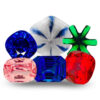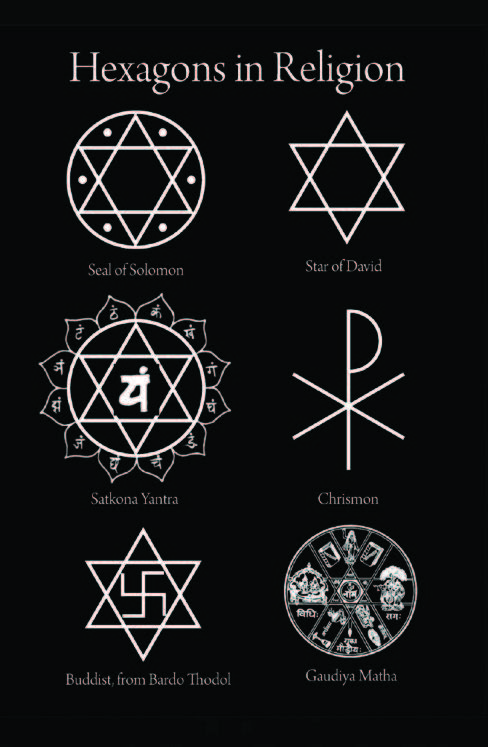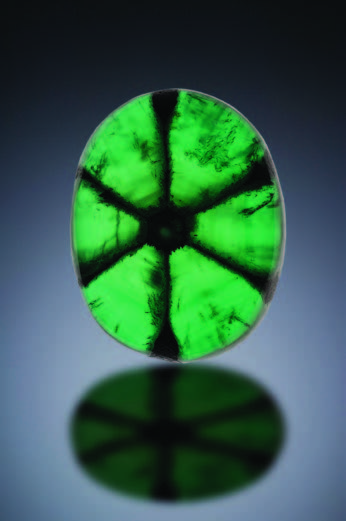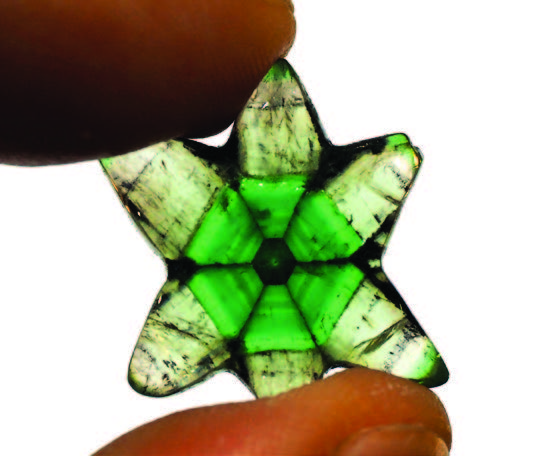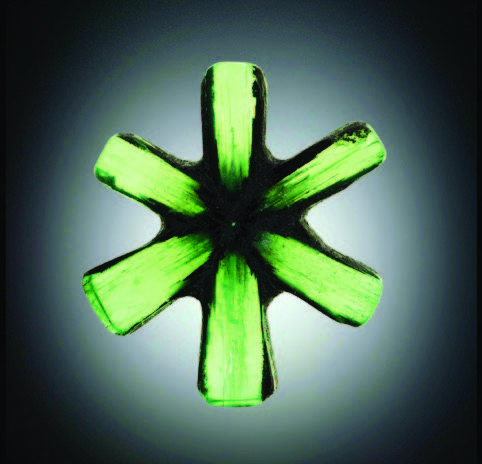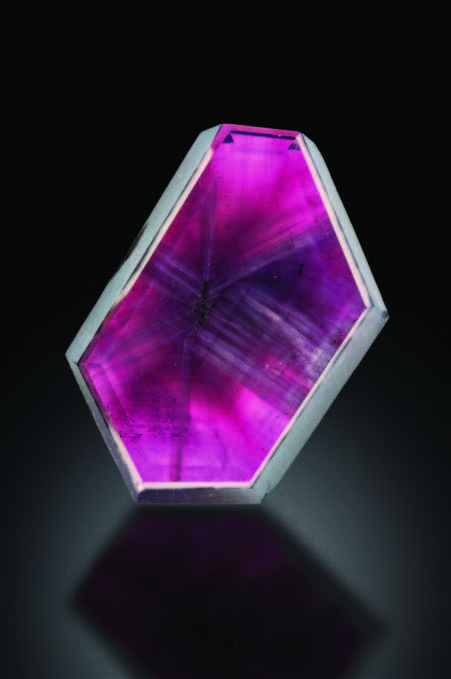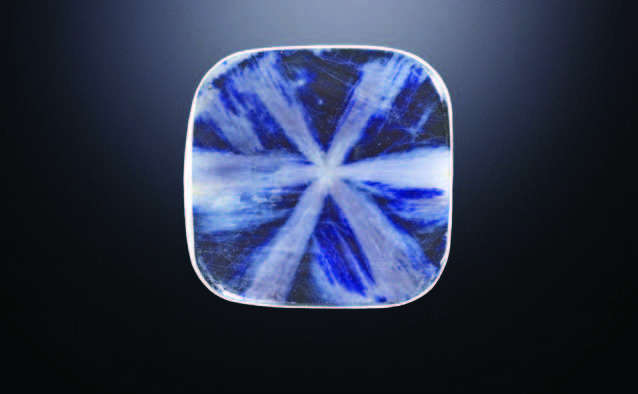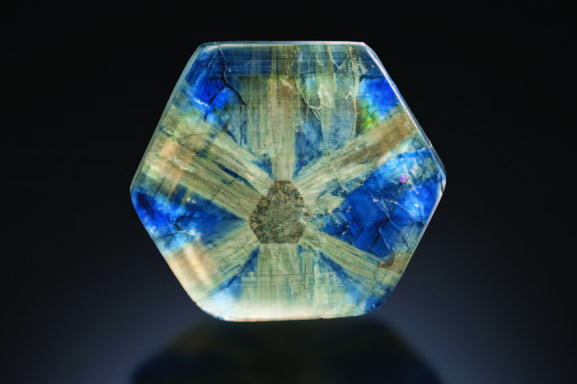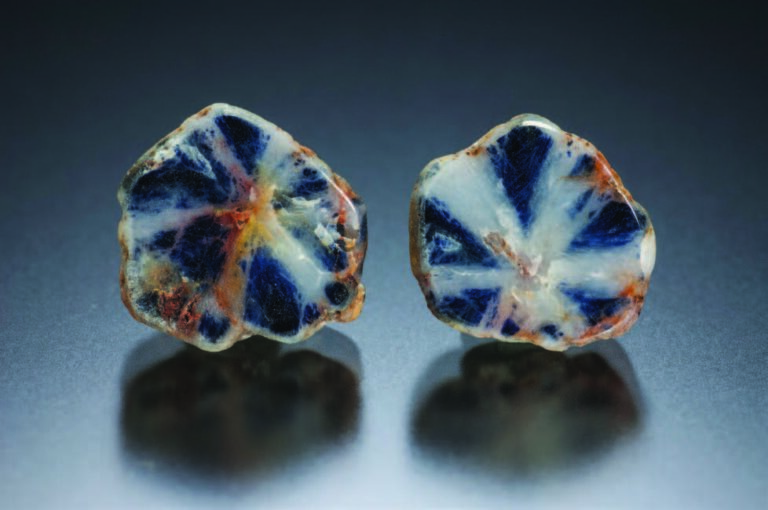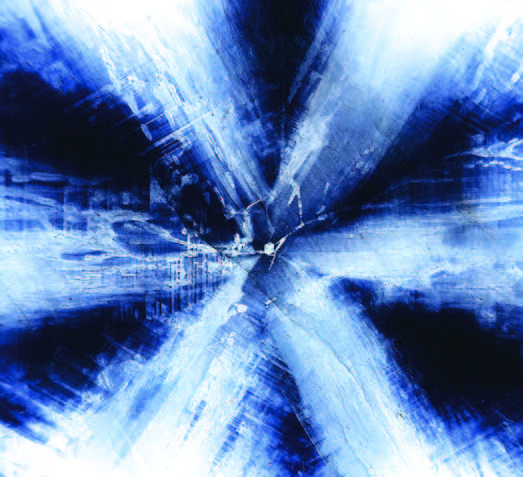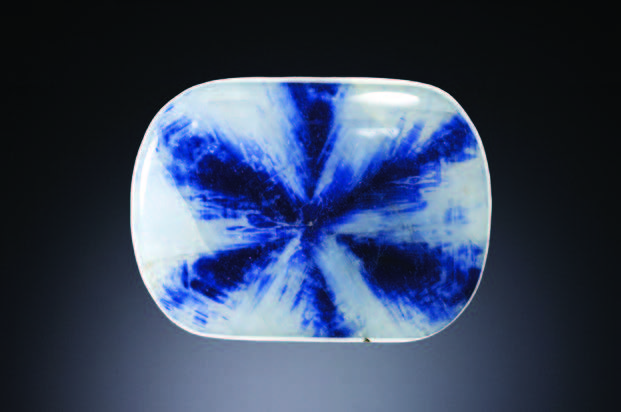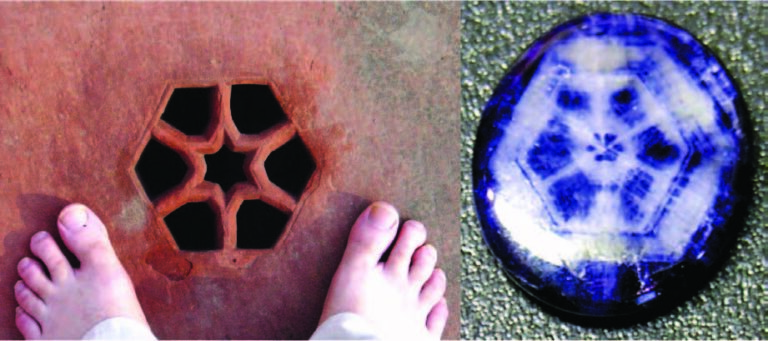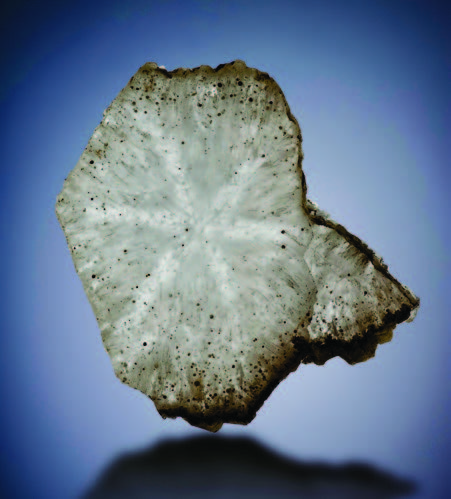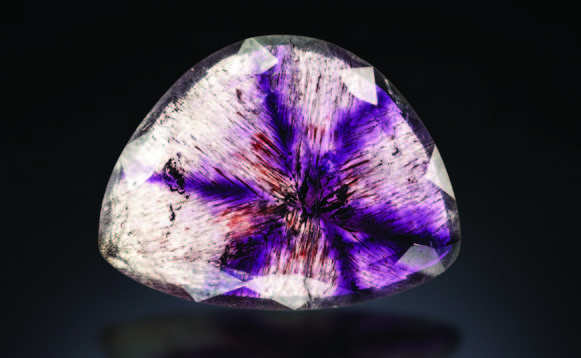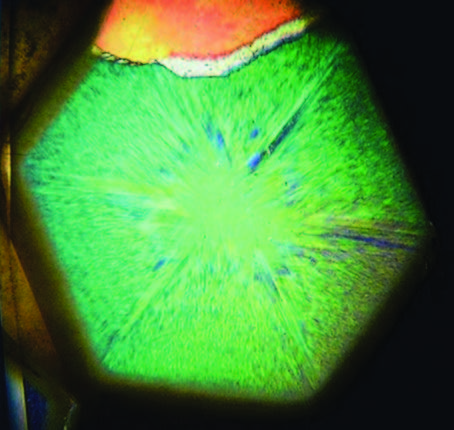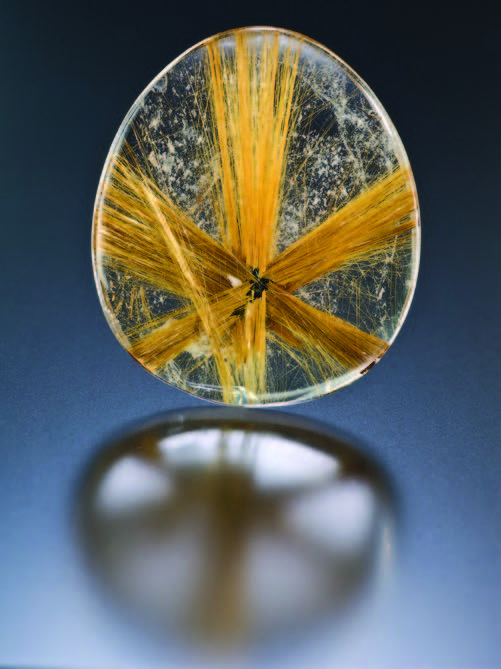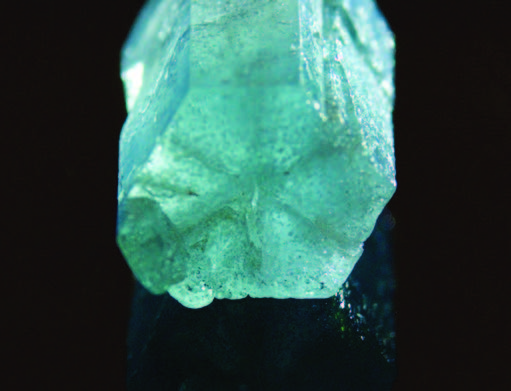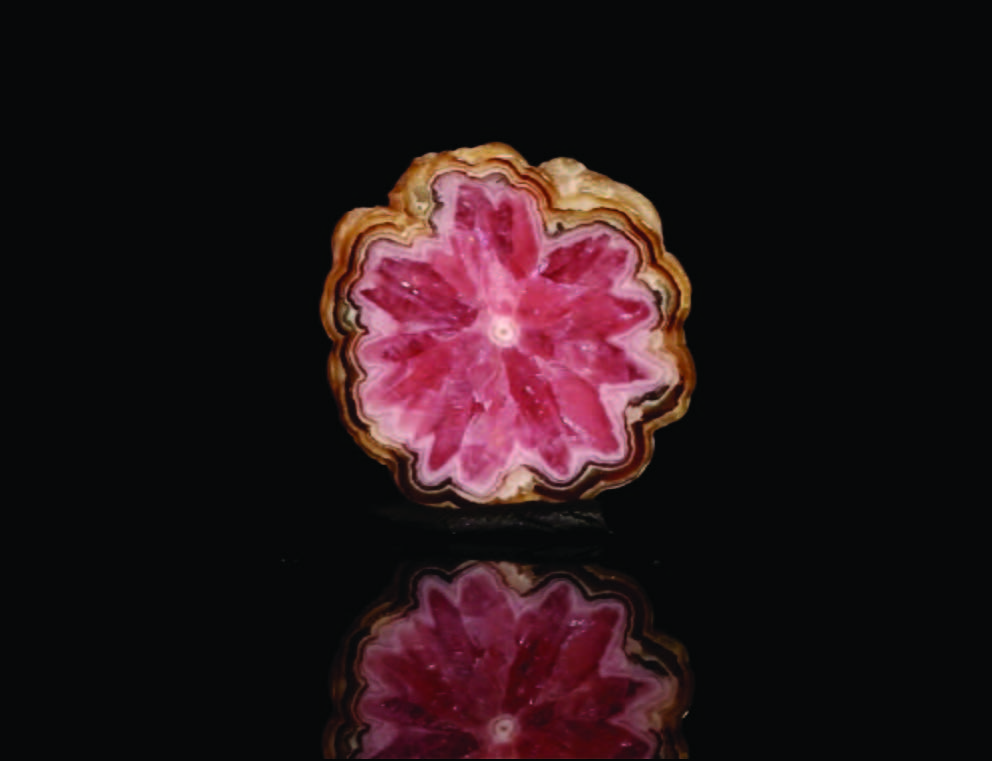Trapiche: The Rising Star : by Jeffery Bergman
Humans are fascinated with geometry and historically the hexagon is the most iconic of popular geometric shapes. Likely first encountered in snowflakes, honeycomb and certain starfish species, the hexagon has been adopted, adapted and incorporated by religions, mysticism, astrology, the occult, architecture and art. Modern satellite photos have even revealed that the jet-stream on Saturn’s North Pole forms a perfect hexagon. Manifestations of the hexagon appear in Buddhism, Christianity, Hinduism, Islam, Jainism and Judaism. The hexagon is arguably the center of sacred geometry, though the reasons behind this symbol’s common appearance in Indic religions and the West have been lost in the mists of antiquity. The hexagon is often featured in the sciences of mathematics, biology, chemistry and, of course, geology. Recent research has revealed the enzymes responsible for encoding synaptic memory within neurons in the human brain form hexagonal microtubules (Craddock 2012). It would seem that humans are hexagonally hardwired, so it should come as no surprise that we are fascinated with hexagons in minerals, especially gemstones. The four most popular types of gemstone forming minerals are corundum, beryl, tourmaline and quartz, all of which feature trapiche and/or trapiche-like gem examples.
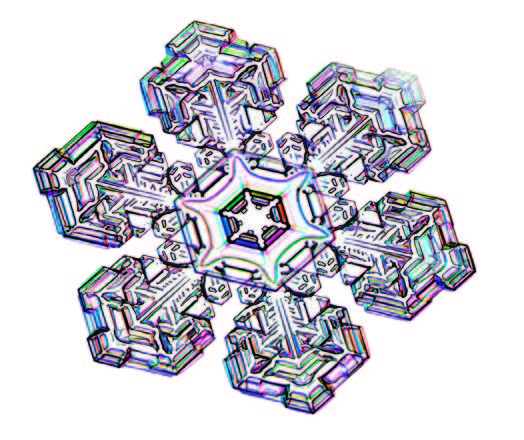
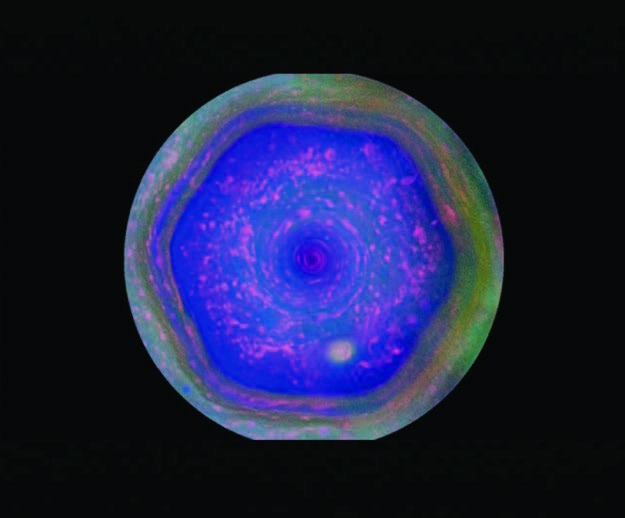
Trapiche gems are characterized by crystallographically equivalent growth sectors that are separated by more or less sharp boundaries of inclusions. The boundaries intersect in a central point or extend from the edge of a central core. Gems that belong to this group include Colombian emeralds, corundum, tourmalines, garnets, and although they only exhibit four arms, chiastolite (a variety of andalusite). Two other features observed in trapiche crystals should be mentioned: trapiche minerals are always characterized by high symmetry (cubic for garnet, hexagonal for emerald, and trigonal for corundum and tourmaline) and all true trapiche gems feature inclusions of organic matter) (Pignatelli et al 2015). In trapichelike gemstones, the texture is caused by the distribution of color-inducing elements or of inclusions in alternating portions of the crystal. This is the case with sapphire, some rubies, spinel, quartz, aquamarine, pezzottaite, rhodochrosite and diamond. Cordierite-indialite intergrowths responsible for Sakura or cherry blossom stone from Japan also produce a trapiche like appearance (Skalwold 2015).
Trapiche Emerald
Colombian trapiche emeralds were first described by the French mineralogist Emile Bertrand (1879), in a meeting at the Société Géologique de France, in which he presented “curious crystals of emerald…from Muso, New Granada” though with no explanation on their formation and prior to them being named (Pignatelli et al.2015). Trapiche de caña de azucar is the Spanish name for the six-spoked cogwheel used to squeeze juice from sugarcane, so adopting the name “Trapiche” for emeralds exhibiting the same pattern is not only logical, but seems quite appropriate as well.
Visually, there are two major groups of trapiche emeralds; occasionally seen are those with beige colored albite radiating spokes separating the emerald sectors, and predominantly those with black carbon rich shale spokes. All trapiche emeralds were originally reportedly from Muzo on the western border of the Cordillera Basin, and erroneously from Chivor on the eastern border. It was later revealed that, in fact, Peña Blanca, also on the western border of the basin, was the actual source of the “Chivor” trapiches (Skalwold 2015). Trapiche emeralds have been found at Coscuez, also on the western border, but have never been described by geologists. Trapiche emeralds have not been found in Chivor, Gachala or Macanal on the eastern side (Pignatelli et al. 2015).
Gems & Gemology Fall 2015 feature article Colombian Trapiche Emeralds: Recent Advances in Understanding Their Formation provides an in-depth explanation for the formation of these fascinating gemological curiosities including a 3-D petrographic examination of their crystals with complete historical, geological, mineralogical, gemological, and crystallographic background. Two examples of non-Colombian trapiche emerald crystals have also been reported, one from the Brazilian state of Goiás and the other from the Mananjary area in Madagascar but they cannot be compared with Colombian samples because their geological formation is unknown (Pignatelli et al 2015).
“A-type” or “standard” trapiches feature dendritic spokes radiating from either a single point at the center, or from an emerald crystal core. A fascinating newer type first noted in 2009 from the Peña Blanca mine are “b-type” or “reverse” trapiches where emerald forms the six arms of the radiating star-like pattern rather than the beige albite or black shale (http://www.mindat.org/XKN-7D7 –Accessed 05 April 2016). And while the vast majority of trapiche emeralds are clarity enhanced by traditional methods, there are occasional very rare examples such as a 6.97-carat extremely rare “reverse” trapiche in the Somewhere In The Rainbow Collection verified as unenhanced by the AIGS lab under the directorship of Dr. Dietmar Schwarz (Fig.9).
“Emerald aficionados sooner or later find themselves seeking a well-formed trapiche for their collection. Once having acquired such a piece, in moments of repose and wonder, the gem gets pulled out of its paper and scrutinized; the color and texture of the very slightly bluish-green cabochon fills and satisfies the senses while the mathematical perfection of the six rays and the central hexagon alert the intellect to appreciate Nature’s design.
Of all the sciences, gemology lends itself to involve much more than just the usual analytic, de- constructive and intellectual phases with which science concerns itself. While science avoids subjectivity and aesthetics, gemology’s object of study, the gem, is nothing less than a thing of beauty, allure, timelessness, rarity, uniqueness, wholeness, perfection of color, and fineness: all immeasurables beyond the realm of science. Many of the world’s best gemologists know this to be true and some of them are able to use that to their advantage.” – author and emerald expert Ron Ringsrud (2016) The first known use of trapiche emerald in jewelry is in an early 19th century gold ring by an unknown artist bequeathed to the V&A museum in London by cleric and poet Reverend Chauncy Hare Townshend (V&A Search the Collections http:// collections.vam.ac.uk/item/O122705/ring-unknown/ –Accessed 05 April 2016). Trapiche emeralds have been featured in fine jewelry from prestigious names such as Bergdorf Goodman, Omi Prive, Spectrum Awards winner Erica Courtney and French joallier Francis Barth (Fig.12). A 172.5-carat Muzo trapiche parure from the collection of Victor Carranza sold for US$140,500 at Heritage Auctions, New York, in May 2012 (Fig.11).

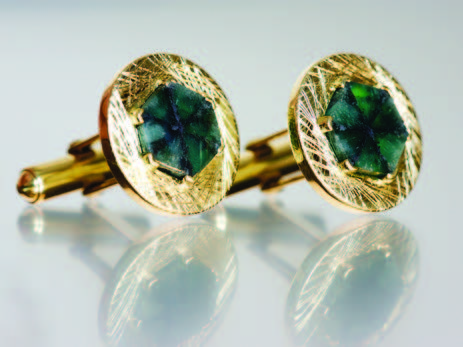
Trapiche Ruby
The first reported trapiche rubies from Burma came from Mong Hsu and were documented by the GIA in 1995. The trapiche texture of these rubies is characterized by dendrites and arms, though they lack a central core (Pignatelli et al.2015). Examples are typically quite small (rarely reaching two carats), often very dark brownish or purplish red, and require slicing into thin wafers in order to enjoy the trapiche pattern and ruby color. Heat treating significantly lightens the body color of the ruby, which can be almost black, and turns the material separating the segments from dark brown to chalky white (Heierman, W. Micro Features, http://www.corunduminium. com/oldsitebackup/page/micro.htm –Accessed 05 April 2016). Trapiche rubies have also been found in Guinea, Kashmir Pakistan, Nepal, Sierra Leone and Tajikistan.
.
Trapiche Sapphire
Trapiche sapphires first appeared on the gem market in early 1996 when 10 samples with a sectored structure were offered at the Basel fair by a Berlin gem dealer (Schmetzer et al.1996). Generally, while the trapiche effect is caused by dark dendritic inclusions containing organic matter, in sapphires it is due to strong color banding parallel to the hexagonal growth zoning (Keifert 2012). These trapiches have been reported from many locations, including Australia, Cambodia, China, France, Kenya, Madagascar, Nepal, Scotland, Sierra Leone, Sri Lanka, Tanzania, Montana USA, and Vietnam.
Commenting on the forum GemologyOnline.Com, Vincent Pardieu opined: “Regarding trapiche sapphires there are to my experience two types: The first one: Stones found from basaltic type deposits which are quite common (I’ve seen many from Pailin, Kanchanaburi, Chanthaburi, some African deposits in Kenya and Madagascar and also in Mogok (probably from the northern area close to Momeik and the western area in Thabeikyin). The other type is found in metamorphic type deposits. To my experience this latest type is much rarer than the “basaltic type” and some stones can be really nice. I’ve seen several stones of this latest type, most of them were from Burma but also one from a trusted source in Sri Lanka.”
In the author’s experience, the basaltic type trapiche gems from Mogok in Burma typically feature a gray to whitish star on a very dark blue to black background, are mostly opaque with only very occasional translucent specimens found. The metamorphic type from Burma are typically semi-
translucent to translucent featuring a dark gray star on a light
gray background. Very rarely, the translucent metamorphic type is found with a gemmy blue on snow white color zoning.
In her documentation of one such 36.16-carat translucent vivid blue on snow white example in Gems &Gemology, Lore Kiefert of the Gübelin Gem Lab reported: “The stone showed a very pronounced blue zoning along the corners of the hexagonal growth structure, while zones corresponding to the prism faces were white. In addition, many of the boundaries between the blue and the white areas displayed elongated
white patches perpendicular to the growth direction of the
prism faces.” (Keifert 2012). The Gübelin Gem Lab’s report
on this exceptional trapiche sapphire included a full page
appendix mentioning that it was an “extremely rare” and “remarkable gemstone” (Gübelin Gem Lab 2012).
Richard Hughes of Lotus Gemological Laboratory wrote: “The trapiche pattern in corundum is usually produced by the unmixing of impurities on irregular surfaces formed by dendritic growth. The pockets of snowflake-like dendrites provide the perfect place to trap impurities. Occasionally, however, the
pattern forms as a result of still-mysterious conditions causing coloring agents to concentrate in a similar spokelike pattern. The 36.16-carat trapiche sapphire that is the subject of this report is of the latter type, where large blue spokes are dramatically set off against a white background. This is shown to great effect by the low-dome cabochon cut, with the star in the center. This particular gem is remarkable for trapiche sapphires, both in terms of its size, the rich blue color of the star, and the contrast between the star and the body of the gem. Thus we award it our coveted Lotus Gem of Distinction honor.” (Lotus Gemology 2014)
Trapiche Tourmaline
In 2004, gem traders began to see sliced crystals of green tourmaline from Zambia which exhibited a growth structure similar to the trapiche pattern known to occur in emerald and ruby. Most of this trapiche tourmaline came from the Kavungu mine southeast of Mwinilunga in northwestern Zambia, though local gem traders also report another locality for this peculiar material in the Kampanda area located southwest of Mwinilunga near the border with Angola.
Some parcels of rough emerald were salted with this rare material, though some separate lots of this peculiar green tourmaline were also offered for sale. Zambian gem traders coined the term “Mercedes Benz Tourmaline” (or erroneously emerald) due to the shape of the trapiche-like inclusions in the center of the slices which bear a striking resemblance to the Benz logo. The trapiche pattern is best appreciated when thin slices of the tourmaline crystals are backlit (Hainschwang 2007).
Trapiche Garnet
Trapiche almandine garnet featuring orientated rutile needle inclusions was reported from Tha-Beik-Kyin Township, west of Mogok, Burma by Ziggi Ellenmountain of Crystal-Treasure. com (http://gemologyonline.com/Forum/phpBB2/viewtopic. php?f=6&t=14773 – Accessed 05 April 2016)
Trapiche Quartz
Trapiche patterns in quartz have been documented in Burma, Colombia, India, Inner Mongolia, Mexico and Russia. While not a true trapiche, rutilated quartz from Brazil occasionally forms spectacular six rayed trapiche-like sprays of golden rutile needles radiating from a central core.
Trapiche Spinel
Study of extremely rare trapiche spinels reportedly from Mogok in Burma suggest the trapiche structure formed during the growth of tabular spinel crystals. A pseudomorphic origin of spinel after ruby is also possible, and is supported by a remnant ruby inclusion detected in one sample (Moe 2011).
Trapiche Aquamarine
An extremely rare specimen of trapiche aquamarine from Erongo, Namibia was discovered in the collection of Ian Kalway, The C Axis, during the Tucson Gemshow of 2016.
Trapiche Pezzottaite
In the Winter 2015 issue of Gems & Gemology, Elise Skalwold and John Koivula reported first- time confirmation of Burmese trapiche-like pezzottaite crystals. Two crystals and several fragments were obtained from Elaine Rhorbach (Gem-Fare) who purchased them in the gem markets on the Thailand/Burma border in 2004. Laboratory analysis revealed these to be the cesium-rich mineral pezzottaite and thus represents the newest trapiche gem mineral to emerge (Skalwold and Koivula 2015).
Trapiche Rhodochrosite
Trapiche-like patterns in rhodochrosite have very rarely been reported from the Capillitas mine in Argentina. Only two specimens have been encountered by Russ Behnke Minerals, while Rusty James of Throwin Stones recently reported encountering a small but perfect six point star matched pair while sawing through some Capillitas rhodochrosite stalactites (http://www.mineralmovies.com/php/mobile/movie.php?id=5 –Accessed 05 April 2016).
Trapiche Diamond
According to the GIA, three-rayed “trapiche” diamond slices are among the scarcest and striking, as they contain a recognizable radiation-symbol pattern. These are only found about once in a couple of thousand slices, and even then it is rare to find distinct coloring (Stone-Sundberg 2015) Fig.24. Also known as “star”, “asteriated” or “sector zoned” diamonds, the hydrogen cloud generated pattern does very rarely produce a six legged star which can be quite spectacular (Rondeau et al.2004).
To sum up fascination with and appreciation for trapiche found in quite a few gem and mineral species.” (https://www. patterns, no-one has said it better than Rusty James of Throwin facebook.com/throwinstones/?fref=ts 8 March 23.55.) Stones: “There’s a rapidly growing almost cult following developing around an interest in the six rayed trapiche shape Have you joined the happy trapiche family?
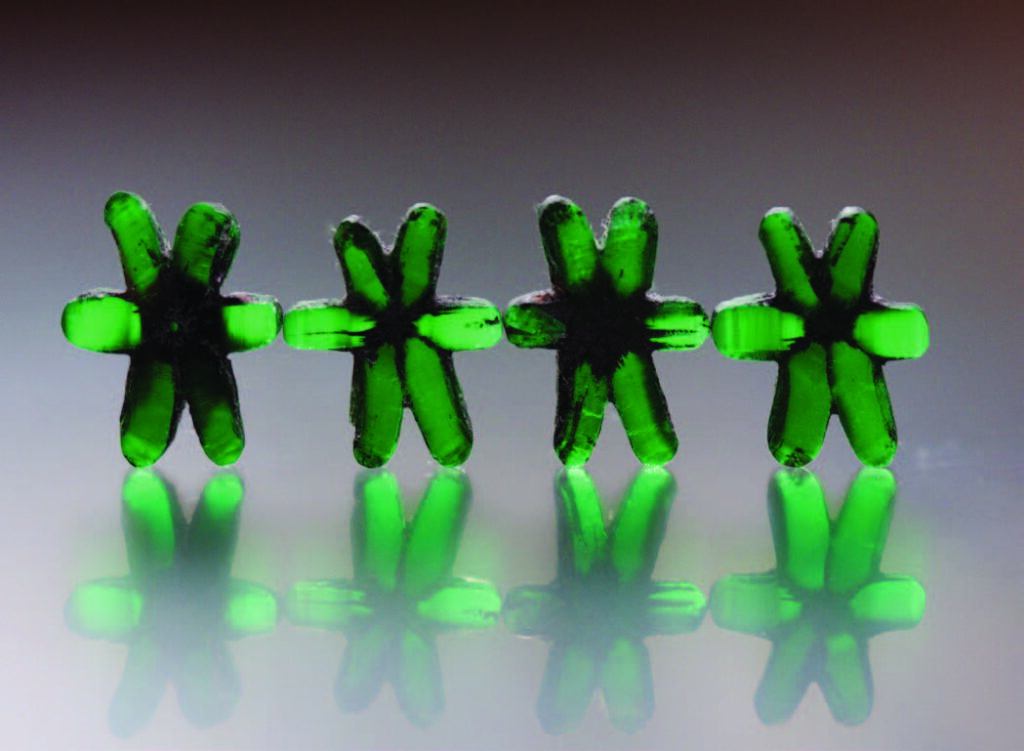
REFERENCES:
GIA calls pezzottaite trapiche not trapiche-like: http://www.gia.edu/gems-gemology/fall-2015-microworldpezzottaite-debuts-trapiche
gem-mineral
GIA calls aquamarine trapiche not trapiche-like: Befi, R. (2012) Trapiche aquamarine from Namibia. GEM NEWS INTERNATIONAL, GEMS
& GEMOLOGY SUMMER 2012 pg 144
Gubelin calls sapphire trapiche not trapiche-like. Kiefert, L. (2012) Unusual trapiche sapphire. GEM NEWS INTERNATIONAL, GEMS &
GEMOLOGY FALL 2012 pg 229
GIA use of “trapiche” diamond: http://www.gia.edu/gems-gemology/summer-2015-gemnews-diamond-slices
No. 2. Gemological precedence has already been set use of the term “reverse” trapiche:
Natural History Museum of Los Angeles: http://www.nhm.org/site/research-collections/mineral-sciences/newacquisitions
Type “A” and type “B” trapiche reference from MinDat: http://www.mindat.org/XKN-7D7
Ringsrud, R., Boehm, E., (2013) Journal of Gemmology 2013 V.33, pg 197 http://raresource.com/raresource/wpcontent/ uploads/2015/02/
Penas-Blancas-Article.pdf
For Further Reading:
http://www.gia.edu/gems-gemology/fall-2015-colombian-trapiche-emeralds-recent-advances-understanding-formation http://www.minsocam.org/ammin/AM55/AM55_416.pdf http://www.gia.edu/gems-gemology/spring-2007-trapiche-tourmaline-zambia-hainschwang http://www.gia.edu/gems-gemology/winter-2015-letters-trapiche-nomenclature http://www.gia.edu/gems-gemology/fall-2015-microworld-pezzottaite-debuts-trapiche-gem-mineral Schmetzer, K. et al. Trapiche Rubies, Gems & Gemology Winter 1996 pg. 242–250
